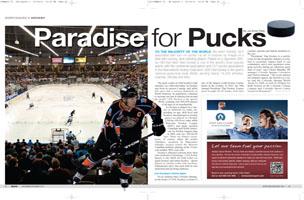
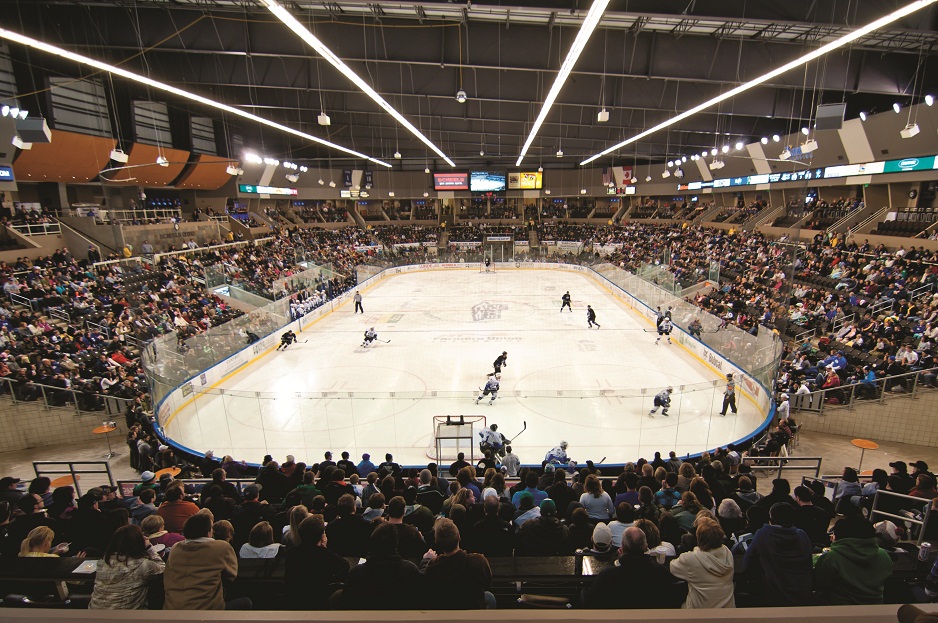 To the majority of the world, the word 'hockey' isn’t associated with ice—or pucks—at all. It conjures up images of a field with running, stick-wielding players. Played on a regulation 300-by-180-foot field, field hockey is one of the world’s most popular sports, with five continental associations and 127 country associations in the International Hockey Federation. USA Field hockey is the sport’s national governing body (NGB), serving nearly 19,000 athletes, coaches, officials and fans.
To the majority of the world, the word 'hockey' isn’t associated with ice—or pucks—at all. It conjures up images of a field with running, stick-wielding players. Played on a regulation 300-by-180-foot field, field hockey is one of the world’s most popular sports, with five continental associations and 127 country associations in the International Hockey Federation. USA Field hockey is the sport’s national governing body (NGB), serving nearly 19,000 athletes, coaches, officials and fans.The puck comes in with hockey’s rink varieties: ice, roller and inline. Ice hockey was born in eastern Canada, and while this sport has a serious skatehold on North America, its popularity continues to increase not just in America but around the world. USA Hockey is the sport’s NGB, counting over 400,000 players of all ages in its membership.
Ice hockey is played on a variety of different ice rinks, depending on age, skill level and location. International ice hockey games are played on Olympic (200-by-100-foot) rinks while National Hockey League (NHL) and many western Canadian and North American ice hockey leagues play on NHL-size ice: 200-by-85 feet. There are always exceptions, of course; when the winter Olympics occurred in Vancouver, Olympic hockey joined the Western Canadian tradition, playing on the 15 percent smaller NHL-size rink.
Hockey’s wheeled versions have their own dedicated followings. USA Roller Sports is the NGB for both roller (or quad) hockey and inline hockey—sports played in similar roller rink facilities (dimensions vary), but each with its own dedicated and growing audience. 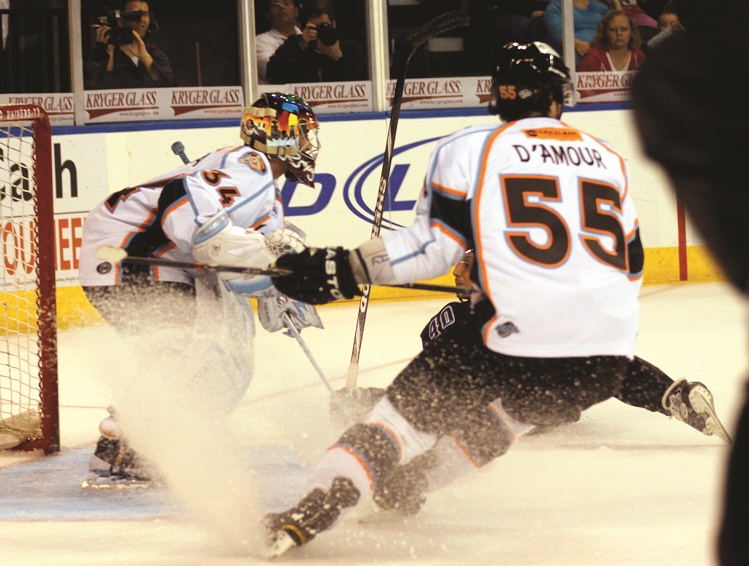

Ice Hockey’s Home Base
It’s no surprise that Colorado Springs, as the home of USA Hockey, is home to one of the largest youth hockey tournaments in the country. In 2001, the 34th Annual Presidents’ Day Hockey Tournament brought 80-90 teams, with their coaches, parents and family members to the city.
“Presidents’ Day Hockey is a terrific event for the hospitality industry in relation to economic impact back to our community, and it also generates some great activity during an otherwise quiet time of year,” says Chelsy Murphy, PR manager, Colorado Springs Convention and Visitors Bureau. “The event utilizes two primary spaces, the Sertich Ice Center and the Colorado Springs World Arena Ice Hall, as well as Honnen Ice Rink located on the Colorado College Campus and Colorado Sports Center located in Monument.”
Sertich Ice Center, located in Memorial Park, features an NHL-size ice surface and bleacher seating for 2,000. The Colorado Springs World Arena Ice Hall, a renowned training facility for ice sports, is home to dozens of world-class athletes, as well as the NCAA Div. I Colorado College men’s hockey team. The facility features two sheets of ice, one Olympic and one NHL, as well as a comprehensive off- and on-ice training program that has attracted athletes from across the world.
An adaptive form of hockey began in the early 1960s in Stockholm Sweden. A Paralympic sport since 1994—with Colorado Springs-based Team USA earning the Gold medal in 2002 and the Bronze medal in 2006—sled hockey uses the same equipment as "stand-up" hockey, except, in place of skates, a cushioned seat mounted on a tubular sled that has skate blades and a center pivot underneath. The player sits four inches above the ice and is held into the sled with Velcro straps. Players use two shortened hockey sticks to handle the puck and propel themselves across the ice, although a “pusher” can also be used, if necessary, to help move a player.
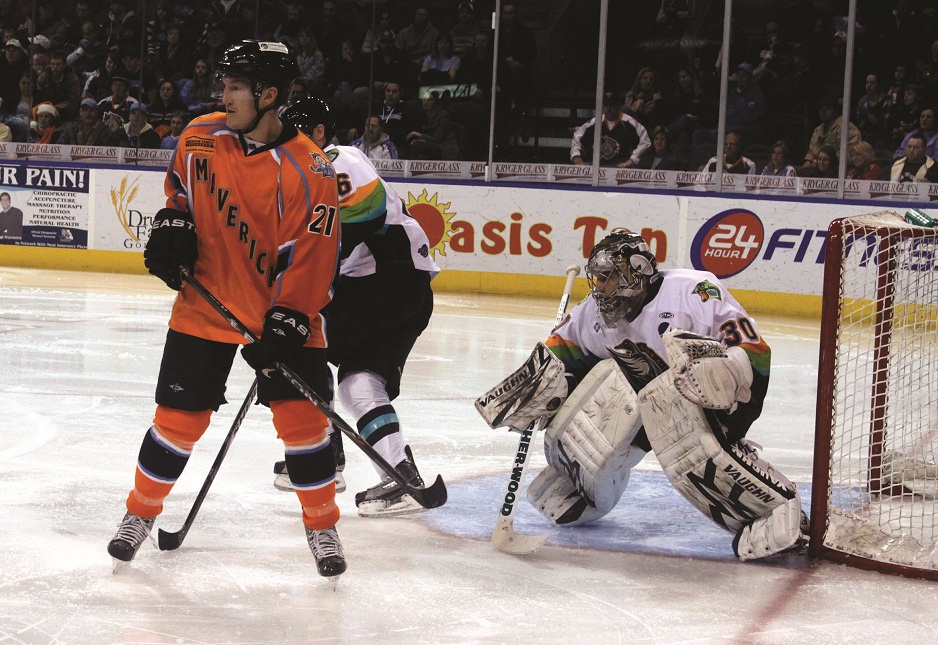 Hockey Across America
Hockey Across AmericaOn Hockey Day in America (Feb. 20), the New York Times hockey blog, Slapshot, took a look at ice hockey growth and participation across America. The numbers revealed a Southeastern hockey surge. In the Sun Belt states with new or newly popular hockey teams, like Washington, D.C., North Carolina, Georgia, Tennessee and Florida, ice hockey is making its greatest growth leaps. Minnesota holds a special distinction as the only hockey stronghold that continues to make significant gains in the sport’s popularity. Granted, this is partially due to ice hockey’s already extraordinary popularity in these states, including Michigan, Massachusetts and New York State. But some hockey experts, including the New York Times analysts, suggest that a new rule in Minnesota youth hockey—the fair play point—is making the difference.
Minnesota
“In every game, at every level, each team gets a certain amount of penalties. If you don’t reach that limit, you get a fair play point,” explains Paul Omodt, coach, Edina Hockey Association and past president, Saint Louis Park Hockey Association. “Coaches have realized that it really makes a difference. You can’t coach strategic play if all of your skilled players are in the penalty box. The fair play point has resulted in a higher level of coaching, and really just a better brand of hockey overall.”
Clearly a proponent of the Fair Play Point, Omodt is also a fan of facilities with at least two sheets of ice. “When you’re playing a tournament in a venue with two or more sheets, you can scout and just watch the other games. It really builds a lot more excitement.” 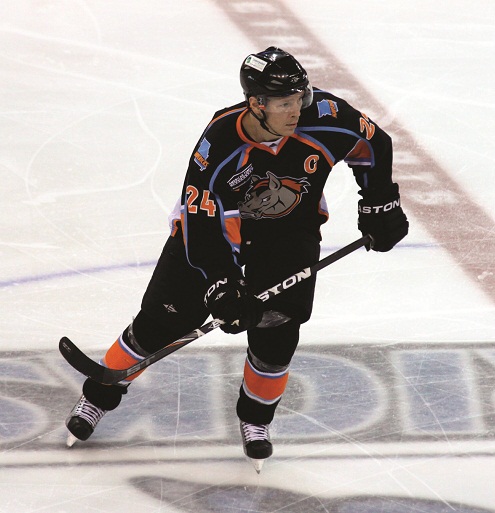

He also advises considering another, less commonly discussed, component of his favorite facilities: good lighting. “The new DECC [Duluth Entertainment Convention Center] in Duluth, Minnesota, is great for players because the lighting is perfectly designed. As a player, you need to see clearly from one end of the ice to the other without a glare. You don’t want it to be like you’re looking into the sun.”
Duluth’s new DECC is a multipurpose facility, including the all-new AMSOIL Arena, which opened last December. With seating for 6,600 for men's and women's hockey, the arena was part of an $80 million project, which includes the arena itself, a skywalk and a 475-car expansion to the DECC's parking ramp. In addition to a sophisticated lighting system, the arena’s “open bowl” design provides clear sightlines throughout the venue, even from the concourse.
North Dakota
In the Fargo-Moorhead area, ask how many sheets of ice are available, and you’re met with a quizzical look.
“Oh, do you mean inside?” says Steve Saxlund, director of sports, Fargo-Moorhead Athletic Commission. But still he has to think about it. This is because the moment temperatures drop below freezing, boards go up all over town, grass between those boards are flooded and outdoor ice rinks abound throughout both towns. Every school has its own ice sheet. Some have two. Hockey, in short, is everywhere.
Of course, there’s plenty of indoor hockey in Fargo-Moorhead, too. The Scheels Arena, home of the United States Hockey League (USHL) Fargo Force, is a 5,000-seat arena with an NHL rink. Home of the 2011 USA Curling National Championships, Scheels is the first phase in a developing project, which will include five indoor NHL regulation ice sheets, and 37 locker rooms, one designated for each Fargo Public School and Shanley High School, among numerous other amenities.
Moorhead, Minnesota, just east of Fargo on the Red River, is home to a number of two-sheet ice hockey facilities, including the Moorhead Sports Center as well as the Moorhead Youth Hockey Arena. Moorhead hosted the 2011 Minnesota Hockey Day, a predictably monumental day in the Minnesota sports schedule. Run in cooperation with the Minnesota Wild NHL team and Fox Sports North, Minnesota Hockey Day included more than fourteen hours of televised consecutive hockey programming, including two outdoor high school games in Moorhead.
The New Heart of Hockey?
The Sun Belt states may have shown the most recent swell in hockey growth, but with new high-profile hockey teams and some exceptional hockey facilities to match, America’s central states could be the site of the next surge.
Missouri
The Missouri Mavericks, named the Central Hockey League (CHL) top franchise of the year this June, play at the Independence Events Center, a state-of-the-art, multi-purpose facility that features two sheets of ice, an 5,800-seat arena, 25 suites, 2,200 paved parking spaces on site, a first-class grill and community ice facility.
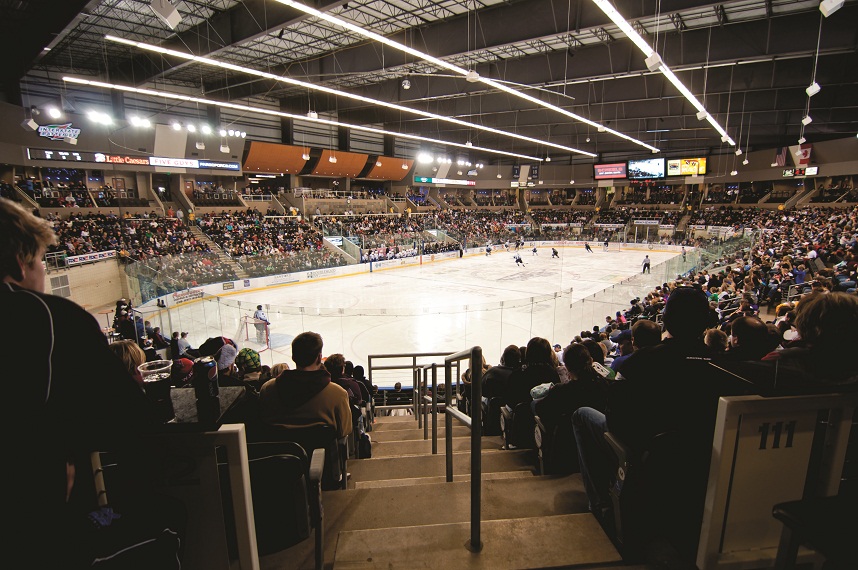 “Having two sheets of ice allows us to offer outside groups such as ice skating and hockey competitions a practice sheet as well as a sheet to compete on. The second sheet of ice, Centerpoint Community Ice, offers a place for the community to come and skate each day. This has been hugely successful for the Events Center as well,” says Cori Day, tourism director, City of Independence Tourism. “The amount of players here is absolutely stunning. It’s definitely in part due to the amazing Jr. Mavs youth hockey program.”
“Having two sheets of ice allows us to offer outside groups such as ice skating and hockey competitions a practice sheet as well as a sheet to compete on. The second sheet of ice, Centerpoint Community Ice, offers a place for the community to come and skate each day. This has been hugely successful for the Events Center as well,” says Cori Day, tourism director, City of Independence Tourism. “The amount of players here is absolutely stunning. It’s definitely in part due to the amazing Jr. Mavs youth hockey program.”The Independence Events Center hosts more than 100 events each year and welcomes more than 500,000 visitors annually. There’s even time for those new to the ice to get acquainted with broomball, an on-ice team game played in street shoes rather than skates.
Oklahoma
Oklahoma City is also vying for the heart of hockey, with another adored hockey team and a remarkable facility. The centerpiece of one of Oklahoma City’s prime venues, the Cox Convention Center, is a nearly 15,000-seat arena. Just a quick walk from the revitalized Bricktown historical district, the Cox Convention Center offers generous seating for concerts, conventions and sporting events. The arena is now home to the Oklahoma City Barons of the American Hockey League (AHL) and the Bricktown Brawlers of the Indoor Football League (IFL).
The arena has received a number of upgrades in recent years, as well, including a new game lighting system, a new scoreboard and a number of new video displays. Cox Convention Center also boasts a highly centralized and convenient location, just minutes from the Will Rogers World Airport, right off I-40, near I-35 in downtown Oklahoma City.
Oklahoma City also has a CHL franchise, the Oklahoma City Blazers, who call the Chesapeake Energy Arena home. Annually, more than one million guests visit Chesapeake Energy Arena, a facility that certainly has experience on its side: more than 700 events have taken place there since the facility opened.
The Phenomenon in Florida
True to the Sun Belt hockey craze, Palm Beach, Florida, is home to a growing population of players and fans—of hockey in all its many forms.
“We’ve definitely seen some substantial activity in ice hockey over the last couple of years,” says George Linley, executive director, Palm Beach County Sports Commission. “We’ve got two great hockey facilities, Palm Beach Ice Works, a 58,000-square-foot Olympic-size training facility, and Palm Beach Skate Zone.”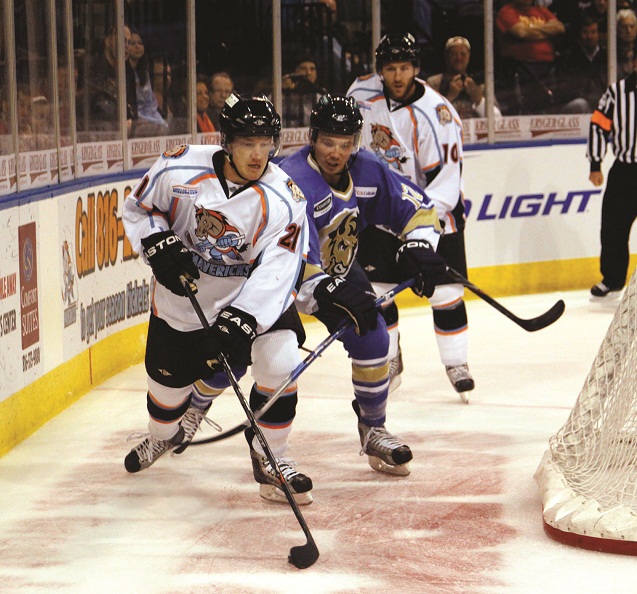

A facility with two ice rinks and one roller rink, Palm Beach Skate Zone offered a unique home for the TORHS (Tournament Of Roller Hockey Series) Inline Hockey National Championship in 2009. Showing evidence of the great working sports relationships in Palm Beach County, the NHL Florida Panthers partnered with the Sports Commission and the facility to provide the sub-flooring required to convert the ice into roller rinks, helping to create a huge success: 150 hockey teams brought 3,000 athletes, generating more than a $1 million in economic impact for the weeklong event.
But the biggest hockey news in Palm Beach is the county’s newest win, the USA Field Hockey National Hockey Festival, one of the largest amateur sporting events in the world. USA Field Hockey (USAFH) will partner with the Palm Beach County Sports Commission to host the Thanksgiving-weekend National Hockey Festival in both 2012 and 2013 at the International Polo Club in Wellington.
Drawing 230 teams and nearly 4,000 athletes from around the United States, Canada, Europe, and the Caribbean, the Festival’s remarkable size makes Palm Beach’s International Polo Club the perfect fit. With over 200 acres of land, consisting of eight polo fields, the Polo Club will enable organizers to lay out an amazing 30 field hockey fields all in one location.

